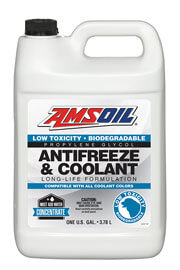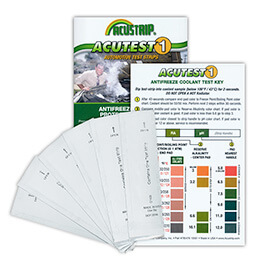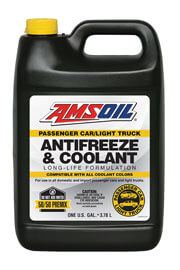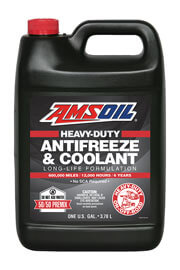Product/Account Links
AMSOIL Accounts
Products
Other Products
AMSOIL Heavy-Duty Antifreeze & Coolant
Product Details
AMSOIL Passenger Car/Light Truck Antifreeze & Coolant provides superior heat transfer and excellent protection against corrosion, freezing and boilover. It provides maximum protection in extreme temperatures and operating conditions, and provides superior protection for aluminum, steel, cast iron, copper, brass and solder alloys.
Product Description
Help Prevent Metallic Corrosion and Erosion
Independent tests reveal AMSOIL Antifreeze/Coolants greatly surpass standards for metallic corrosion and erosion, achieving nearly perfect scores in ASTM corrosion and erosion testing on cast aluminum cylinder heads, steel, copper, solder, brass and cast iron and aluminum water pumps.
Independent tests reveal AMSOIL Antifreeze/Coolants greatly surpass standards for metallic corrosion and erosion, achieving nearly perfect scores in ASTM corrosion and erosion testing on cast aluminum cylinder heads, steel, copper, solder, brass and cast iron and aluminum water pumps.

Anti-Scale
AMSOIL Antifreeze/Coolants are poly-organic acid formulations that do not contain inorganic salts (phosphate, nitrate, nitrite, silicate, borate, amine) found in conventional and hybrid organic acid (HOAT) antifreeze/coolants. These materials are responsible for almost all scaling issues in cooling systems, and they can also precipitate to form scale if the antifreeze/coolant inhibitor system is at the wrong pH or mixed with incompatible products. AMSOIL Antifreeze/Coolants virtually eliminate scaling problems.
Cavitation/Pitting Protection
AMSOIL Heavy-Duty Antifreeze & Coolant effectively protects cylinder liners against cavitation erosion/corrosion pitting, without the problems associated with nitrite and nitrite/molybdate technology. Nitrites can cause aluminum corrosion, and they are being banned from coolants used by a growing number of manufacturers in both the heavy-duty and automotive markets. AMSOIL Heavy-Duty Antifreeze & Coolant is a top-performing technology that performs extremely well in ASTM D7583 (John Deere Cavitation Test) testing.
Long-Life Formulations
AMSOIL Antifreeze/Coolants do not contain inorganic salts that deplete over time and turn into scale deposits. Their unique blend of organic acids provide durable and long-lasting protection of cooling system components. Passenger Car/Light Truck Antifreeze & Coolant can be used for 150,000 miles or five years, whichever comes first, in passenger cars and light trucks. Heavy-Duty Antifreeze & Coolant can be used for 600,000 miles, 12,000 hours of operation or six years, whichever comes first, in heavy-duty and off-road applications.
Compatible With Other Fluids
AMSOIL Antifreeze/Coolants are compatible with all ethylene and propylene antifreeze and coolant colors, as well as all plastics and elastomers (hoses, gaskets, etc.) found in cooling systems. However, mixing propylene and ethylene glycol formulations can make it difficult to predict freeze protection. If mixing for top-off is unavoidable, it is recommended to flush the cooling system at the next convenient opportunity.
AMSOIL HEAVY-DUTY ANTIFREEZE & COOLANT (ANTHD)
- Pre-mixed 50/50 with high-purity water.
- Fully formulated: DOES NOT require the use of supplemental coolant additives (SCAs) or extenders.
- All-organic formulation is further enhanced with anti-scalant, anti-fouling and water-pump lubrication additives.
- Phosphate-, nitrate-, nitrite-, silicate-, borate and amine-free.
- Boil-over protection up to 265°F with a 15 psi radiator cap.
- Freeze protection down to -34°F.
APPLICATIONS
AMSOIL Heavy-Duty Antifreeze & Coolant is recommended for applications requiring any of the following specifications:
ASTM D4985, D6210 • Case IH • Caterpillar EC-1 • Chrysler MS7170 • Cummins CES14603 • Detroit Diesel 7SE298, 93K217 • Fiat Professional; Fiat Truck • Ford WSS-M97B51-A1 • Freightliner 48-22880 • John Deere 8650-5 • Mack Truck CNH • MTU MTL5048, 5049 • New Holland • PACCAR: Kenworth, Peterbilt • TMC of ATA RP329, 330, 338 • US Military CID A-A-52624A
SERVICE LIFE
Protection up to 600,000 miles, 12,000 hours or 6 years, whichever comes first.
Heavy-Duty Antifreeze & Coolant is the best option for mixed fleets of both passenger-vehicle and heavy-duty applications that want to use one antifreeze/coolant. Heavy-Duty Antifreeze & Coolant can be used in non-heavy-duty applications, but with a drain interval of 150,000 miles or five years, whichever comes first.
Directions for Use
- Do not add water.
- Do not remove radiator cap when engine is hot.
- Antifreeze/coolant (new or used) is hazardous. Clean up and dispose of properly following local regulations.
- Check and maintain coolant level at every oil-change interval.
- Check owner's manual for additional maintenance and top-off guidelines.
AMSOIL Antifreeze/Coolants are poly-organic acid formulations that do not contain inorganic salts (phosphate, nitrate, nitrite, silicate, borate, amine) found in conventional and hybrid organic acid (HOAT) antifreeze/coolants. These materials are responsible for almost all scaling issues in cooling systems, and they can also precipitate to form scale if the antifreeze/coolant inhibitor system is at the wrong pH or mixed with incompatible products. AMSOIL Antifreeze/Coolants virtually eliminate scaling problems.
Cavitation/Pitting Protection
AMSOIL Heavy-Duty Antifreeze & Coolant effectively protects cylinder liners against cavitation erosion/corrosion pitting, without the problems associated with nitrite and nitrite/molybdate technology. Nitrites can cause aluminum corrosion, and they are being banned from coolants used by a growing number of manufacturers in both the heavy-duty and automotive markets. AMSOIL Heavy-Duty Antifreeze & Coolant is a top-performing technology that performs extremely well in ASTM D7583 (John Deere Cavitation Test) testing.
Long-Life Formulations
AMSOIL Antifreeze/Coolants do not contain inorganic salts that deplete over time and turn into scale deposits. Their unique blend of organic acids provide durable and long-lasting protection of cooling system components. Passenger Car/Light Truck Antifreeze & Coolant can be used for 150,000 miles or five years, whichever comes first, in passenger cars and light trucks. Heavy-Duty Antifreeze & Coolant can be used for 600,000 miles, 12,000 hours of operation or six years, whichever comes first, in heavy-duty and off-road applications.
Compatible With Other Fluids
AMSOIL Antifreeze/Coolants are compatible with all ethylene and propylene antifreeze and coolant colors, as well as all plastics and elastomers (hoses, gaskets, etc.) found in cooling systems. However, mixing propylene and ethylene glycol formulations can make it difficult to predict freeze protection. If mixing for top-off is unavoidable, it is recommended to flush the cooling system at the next convenient opportunity.
AMSOIL HEAVY-DUTY ANTIFREEZE & COOLANT (ANTHD)
- Pre-mixed 50/50 with high-purity water.
- Fully formulated: DOES NOT require the use of supplemental coolant additives (SCAs) or extenders.
- All-organic formulation is further enhanced with anti-scalant, anti-fouling and water-pump lubrication additives.
- Phosphate-, nitrate-, nitrite-, silicate-, borate and amine-free.
- Boil-over protection up to 265°F with a 15 psi radiator cap.
- Freeze protection down to -34°F.
APPLICATIONS
AMSOIL Heavy-Duty Antifreeze & Coolant is recommended for applications requiring any of the following specifications:
ASTM D4985, D6210 • Case IH • Caterpillar EC-1 • Chrysler MS7170 • Cummins CES14603 • Detroit Diesel 7SE298, 93K217 • Fiat Professional; Fiat Truck • Ford WSS-M97B51-A1 • Freightliner 48-22880 • John Deere 8650-5 • Mack Truck CNH • MTU MTL5048, 5049 • New Holland • PACCAR: Kenworth, Peterbilt • TMC of ATA RP329, 330, 338 • US Military CID A-A-52624A
SERVICE LIFE
Protection up to 600,000 miles, 12,000 hours or 6 years, whichever comes first.
Heavy-Duty Antifreeze & Coolant is the best option for mixed fleets of both passenger-vehicle and heavy-duty applications that want to use one antifreeze/coolant. Heavy-Duty Antifreeze & Coolant can be used in non-heavy-duty applications, but with a drain interval of 150,000 miles or five years, whichever comes first.
Directions for Use
- Do not add water.
- Do not remove radiator cap when engine is hot.
- Antifreeze/coolant (new or used) is hazardous. Clean up and dispose of properly following local regulations.
- Check and maintain coolant level at every oil-change interval.
- Check owner's manual for additional maintenance and top-off guidelines.
Product Size
| Code | Package Size | Unit of Measure | Product |
|---|---|---|---|
| ANTHD1G (ANTHD1G-EA) | Gallon | Each | Heavy-Duty Antifreeze & Coolant |
| ANTHD1G (ANTHD1G-CA) | Gallon | Case of 4 | Heavy-Duty Antifreeze & Coolant |
| ANTHD55 (ANTHD55-EA) | 55-Gallon Drum | Each | Heavy-Duty Antifreeze & Coolant |
Technical Information
Extra Information
AMSOIL Antifreeze / Coolants
AMSOIL offers three coolants, all of which offer a unique blend of organic acids. We use di-acid technology, which means both ends of the organic acid are active. This makes them work faster and form stronger bonds for enhanced protection.
- AMSOIL Passenger Car & Light Truck Antifreeze & Coolant is formulated for all passenger cars and light trucks. It is premixed 50/50 with high-quality water.
- AMSOIL Heavy-Duty Antifreeze & Coolant is dialed in for the unique needs of on- and off-road heavy-duty applications. It is also premixed 50/50 with high-quality water.
- AMSOIL Low Toxicity Antifreeze and Engine Coolant is a 100-percent concentrate polyglycol formulation for situations that call for a low-toxicity product
AMSOIL offers three coolants, all of which offer a unique blend of organic acids. We use di-acid technology, which means both ends of the organic acid are active. This makes them work faster and form stronger bonds for enhanced protection.
- AMSOIL Passenger Car & Light Truck Antifreeze & Coolant is formulated for all passenger cars and light trucks. It is premixed 50/50 with high-quality water.
- AMSOIL Heavy-Duty Antifreeze & Coolant is dialed in for the unique needs of on- and off-road heavy-duty applications. It is also premixed 50/50 with high-quality water.
- AMSOIL Low Toxicity Antifreeze and Engine Coolant is a 100-percent concentrate polyglycol formulation for situations that call for a low-toxicity product






